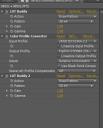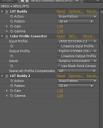
-
I use GH1 and GH2 for photo, too. The adjustment from Color Checker Passport looks great, but $99. Is it worth?
http://forums.dpreview.com/forums/readflat.asp?forum=1041&message=37905620
-
I don't know.
It depends on your needs.
You can check chinese color books on ebay and photo sites on how to use them for color calibration.
And how reliable they are. -
I have it and am satisfied with the purchase. I love that it is a complete all in one system. Color calibration and an 18% grey card for white balance in a slim sturdy compact hard case that you can throw in a small bag or large pocket. It also comes with calibration software that recognizes the passport in an image and automatically creates a color profile.
The size advantage is also a disadvantage as each chart is small and you need to be fairly close when shooting.
Overall it is a bargain for the passport and software in one easy to use package. -
What is possible is to use after effects and use built in convert to profile etc effects. After Effects is a fully color managed application. In addition there are lots of apps floating around that let you do icc/icm>LUT conversion. After Effects is a LUT aware application. I do feel it would be an overkill though. It seems much easier to properly white balance your shot and then color grade it to the way you like (for example qualify a yellow region that bothers you and then dial it down in the ColorFinesse (ships for free with AE), perception of what is accurate varies from person to person...
-
Hmm. Do you know which AE effect specifically could interpret a color profile from the X-rite passport? It would be interesting to do it that way, just to neutralize footage before editing. I'm looking at doing that as a first step since I also have to convert to an edit format anyway and I can render that out of AE (e.g. ProRes, DNxHD, whatever)
-
@dkitsov
I have the calibr8 colorchart SG and I am able to do icc profiling with the macbeth profile maker software, but I have never seen something that can transform icc to lut.
If you have a link to something please let me know.
so far I've couldn't incorporate the workflow for video just for stills.
-
@lunelson Effects>Utility>Color Profile Converter. Will work if x-rite color passport can produce real ICC color profiles.
@andres see attached screenshot, if you do not understand ask questions
ProLost has some nice writeups about color workflow in AfterEffects
 icctolut.JPG353 x 439 - 34K
icctolut.JPG353 x 439 - 34K
 icctolut.JPG353 x 439 - 34K
icctolut.JPG353 x 439 - 34K -
I don't use aftereffects, are those export setting for generating lut. If so that is wonderful news. I normally work in Avid / final cut and then sent to Color for grading.
If I could import a Lut would be great for projects.
I really don't understand those attachments but i'll be opening AE and playing a little bit.
thanks, will ask questions afterwards
-
Let me to point out that a capture device icc color profile is nothing else but a LUT in a wrapper.
Let me also point out that LUTs or ICCs are not a valid tool for a perfect color matching on a capture device. LUT is to be used to change a look or to adjust for some known invariable (like s-curve, or log). The reason they are not a valid tool for a capture device color management is that what you capturing is moving target: light changes, subject changes, exposure changes, iso changes, the device (sensor) changes throughout a take too. The only two useful scenarios I see are
a) you have a studio setup with fixed light and neutral walls, with the same camera settings same iso, same exposure, same lens, same everything - go ahead create a profile and use it for all of the work you do with all the same settings you have created profile with (catalouge shooting?)
b) you shoot with more then one camera and you want to align them to each other in order to remove one of the variables in a grading process - shoot calibration chart with two of them in the same setup (fixed source of light (ideally close to the sweet spot of the sensor (ie some sensors are best performing at 5000k), with the same settings and the same exposure. Create your profile and then use it in a first step of color grading. Needless to say that you cannot shoot your target in a still mode and then use created profile to process video footage. You must shoot in video mode and then capture a frame
I have a strong feeling that icc profiling is not worth it for video or any other capture device. But by all means shoot a CamAlign chart with each take to assist in grading later. -
So, x-rite color checker passport bundled software does not allow for creation of an icc/icm color profiles. One can use a target that comes with color checker to create an icc profile with a professional color profiling solutions (Ks of $). What color checker does is to generate a DNG color profile which maybe applied only to RAW or DNG files. So this makes it unusable for video even if you take Render to frames>Tiff or Jpeg through camera raw>open tiff/jpeg sequence in AE.
-
I am dropping in late on the discussion, you could use the free AE plugin MBR Color Corrector 2: www.mattroberts.org/MBR_Color_Corrector/ 8bit version is free. It helps matching cameras once you have shot your scene with a colorchart inside.
-
johanson - Thanks for the link to the MBR Color Corrector plugin. Looks very interesting. I have used profiles for film scanners, and found them very useful. They not only speed up the work flow, but insure far more accurate color adjustments with less degradation to the image.
-
Here is a good article over at Pro Video Coalition about why a Colorchecker/Macbeth chart is almost useless for video production:
http://provideocoalition.com/aadams/story/what-good-is-a-macbeth-colorchecker-chart
-
I use one with DaVinci Resolve and it works well. Keep in mind that they are not designed to work with poorly white balanced footage. The linked article is promoting an alternative product! ;-)
-
A Macbeth color chart is not useless for video, it is useful. He has it backwards.
-
Davinci Resolve has built-in correction tools which, with properly exposed and already reasonably closely balanced footage (as Caveport said) automatically do the advanced corrections required by the Macbeth charts (including the x-rite, sekonic, and other "colour checkers" and the passport series). The article is right in a the still photography version of those tools is a bit out of gamut for REC709, but you'll still get a damn close match that is quite useful. I certainly see the point in using the product advertised in that article, especially if you want to manually match your colours, but there's absolutely nothing wrong with using the Colour Checker Passport to get you at a solid base. I then use FilmConvert to take it to the basic film look I want, then apply my style grade on top of that. Remember: correction LUTs before conversion LUTs before style LUTs.
Howdy, Stranger!
It looks like you're new here. If you want to get involved, click one of these buttons!
Categories
- Topics List23,992
- Blog5,725
- General and News1,354
- Hacks and Patches1,153
- ↳ Top Settings33
- ↳ Beginners256
- ↳ Archives402
- ↳ Hacks News and Development56
- Cameras2,367
- ↳ Panasonic995
- ↳ Canon118
- ↳ Sony156
- ↳ Nikon96
- ↳ Pentax and Samsung70
- ↳ Olympus and Fujifilm101
- ↳ Compacts and Camcorders300
- ↳ Smartphones for video97
- ↳ Pro Video Cameras191
- ↳ BlackMagic and other raw cameras116
- Skill1,960
- ↳ Business and distribution66
- ↳ Preparation, scripts and legal38
- ↳ Art149
- ↳ Import, Convert, Exporting291
- ↳ Editors191
- ↳ Effects and stunts115
- ↳ Color grading197
- ↳ Sound and Music280
- ↳ Lighting96
- ↳ Software and storage tips266
- Gear5,420
- ↳ Filters, Adapters, Matte boxes344
- ↳ Lenses1,582
- ↳ Follow focus and gears93
- ↳ Sound499
- ↳ Lighting gear314
- ↳ Camera movement230
- ↳ Gimbals and copters302
- ↳ Rigs and related stuff273
- ↳ Power solutions83
- ↳ Monitors and viewfinders340
- ↳ Tripods and fluid heads139
- ↳ Storage286
- ↳ Computers and studio gear560
- ↳ VR and 3D248
- Showcase1,859
- Marketplace2,834
- Offtopic1,320







